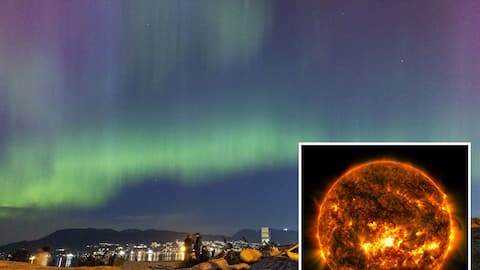Northern lights to be visible across US this entire week
What's the story
The northern lights, or aurora borealis, could be visible in parts of the United States this week following a series of solar storms. The Storm Weather Prediction Center (SWPC) of the National Oceanic Atmospheric Association (NOAA) has reported multiple coronal mass ejections (CMEs) from the Sun heading toward Earth. "Solar activity was elevated through the weekend and various events, including solar flares and filament eruptions, were associated with CMEs," NOAA stated in a recent publication.
Solar Impact
CMEs expected to reach Earth, triggering geomagnetic storm watch
The CMEs are anticipated to reach Earth starting July 29, following an event that took place early on July 27. The NOAA has not ruled out the possibility of additional CME arrivals due to the number of active regions and complex sunspot groups. In response, a Geomagnetic Storm Watch has been issued and will remain in effect until Wednesday.
Aurora forecast
Solar storms could lead to more northern lights sightings
Earlier this summer, the northern lights were visible across the US following the strongest geomagnetic storm in two decades. NASA satellites have been tracking these CMEs as they move away from the Sun and toward Earth's magnetic field. The SWPC is monitoring these developments and providing forecasts for potential sightings of the northern lights throughout the week.
Daytime display
Intense solar storms expected during daylight hours
The most intense solar storms, classified as G3 (strong) levels, are expected to occur while most of the eastern US is in daylight between 8:00 a.m. and 12:00 noon ET. Additional CME arrivals could lead to more possible sightings throughout the week. Weather conditions also significantly affect visibility, with fair weather expected across most of Canada and northern states in the US.
Global phenomenon
Geomagnetic storms could create dazzling auroras worldwide
Geomagnetic storm warnings have been issued in response to massive solar explosions, and starting Tuesday night, these storms may produce breathtaking auroras in the northern United States, Europe, and southern Australia. Mike Bettwy, operations chief of the US-based Space Weather Prediction Center, stated on Tuesday, "As a result, the potential for space weather has ramped up significantly." The CMEs are likely to arrive from Tuesday to Thursday with "geomagnetic storm watches" declared on those days.
Storm warning
'Strong' geomagnetic storm warning issued by NOAA
The impact of the activity is most likely to occur on Tuesday owing to a "strong" geomagnetic storm warning of G3 on the NOAA scale. This spectacle may become visible in Scotland over the following three nights but could be impeded by limited hours of darkness. Aurora australis, the southern lights, could also be visible in southern Tasmania and similar latitudes.
Space weather impact
CMEs can affect satellites, GPS systems, and power grids
About a billion tons of plasma are released during CME eruptions, along with a magnetic field that travels from the Sun toward Earth. This week, two CMEs that were heading toward Earth combined to create what is referred to as a "Cannibal CME." The NOAA has issued a warning that more CMEs are continuing to erupt, indicating more could be on their way.
